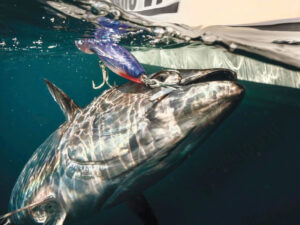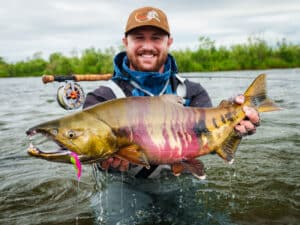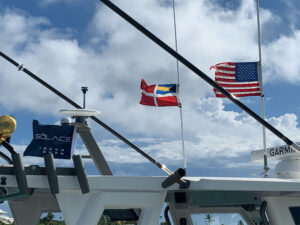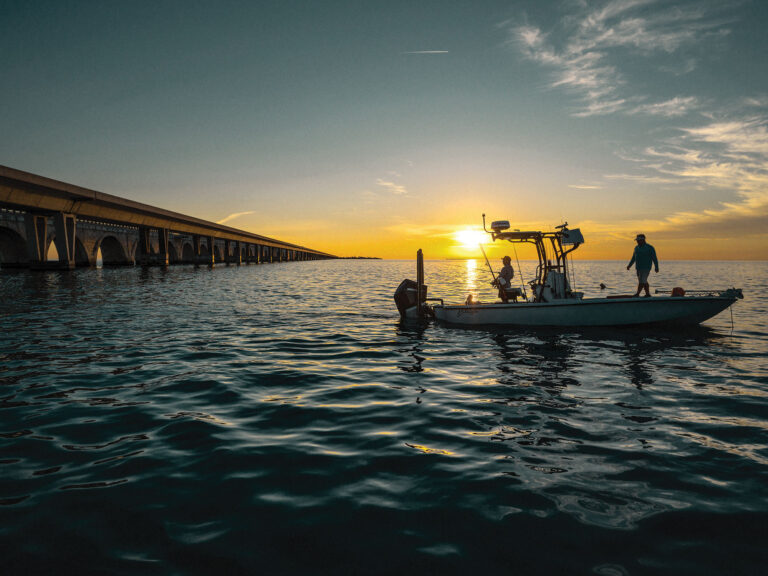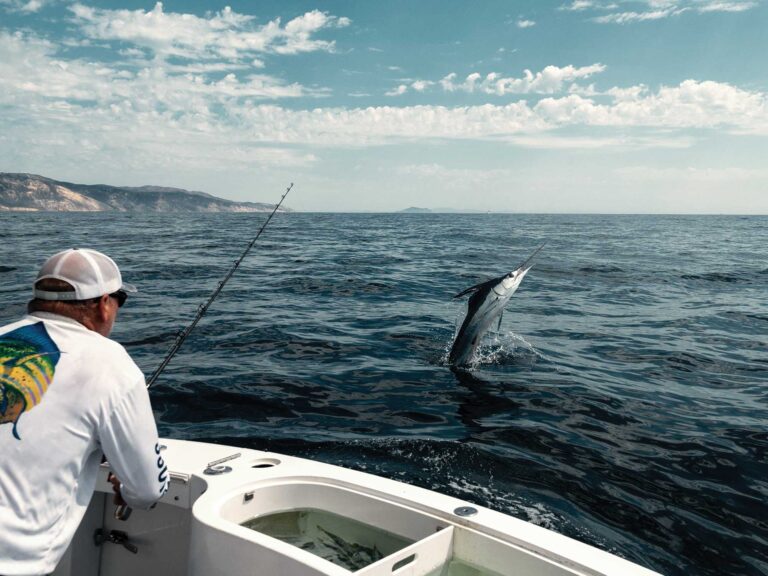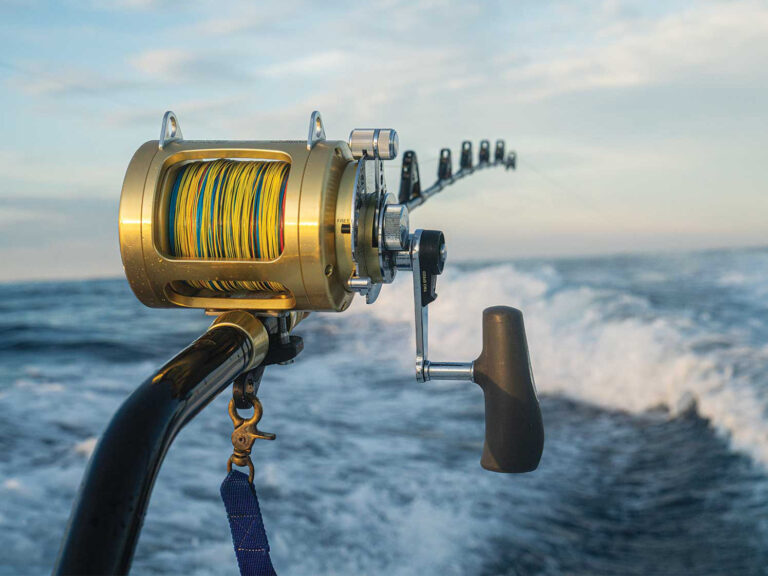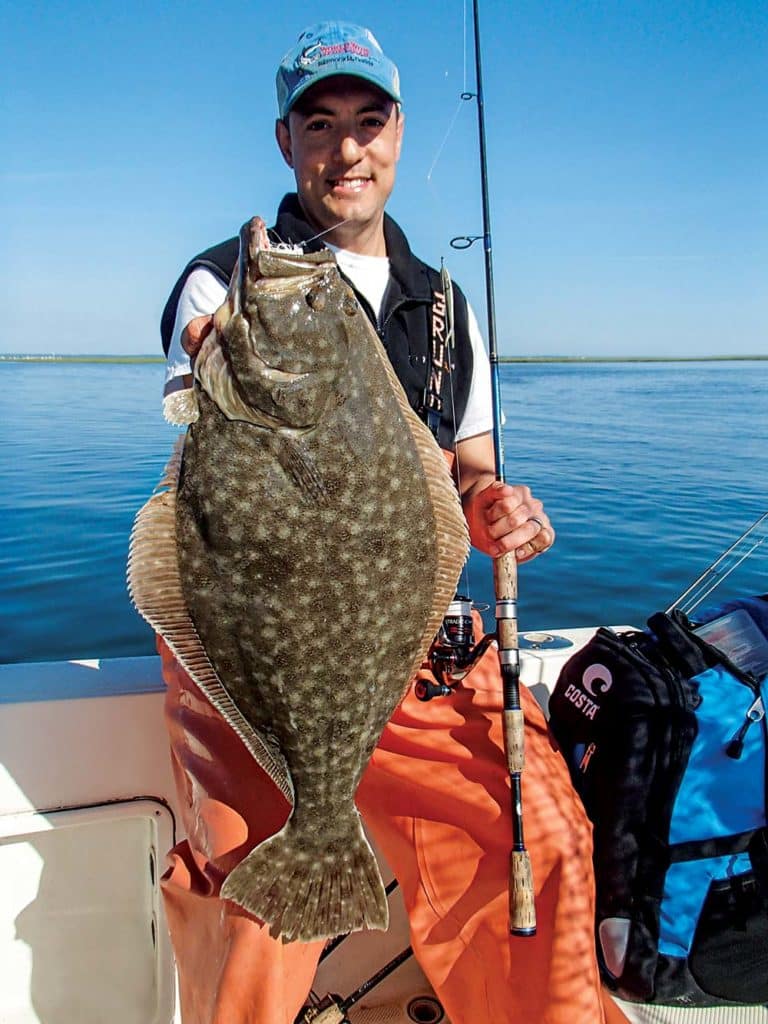
While most anglers think of fluke fishing as a shallow-water affair, fluke over the 10-pound mark hunker down in the dark, deep reaches of shipping channels, offshore reefs and submarine holes. Strategies used by doormat hounds differ from the traditional fluke tactics in order to match wits with flatfish big enough to crack rods and snap lines. It all starts by going deep.

Northeast and Mid-Atlantic Fluke Fishing
Like most Northeast and mid-Atlantic saltwater species, summer flounder (aka fluke) migrate, but they do it a little differently. Fluke spend winter along the continental shelf off the Northeast coast, then start moving back inshore in early spring, later stacking up in the bays and nearshore waters throughout the summer before returning once again to their offshore wintering grounds sometime in October.
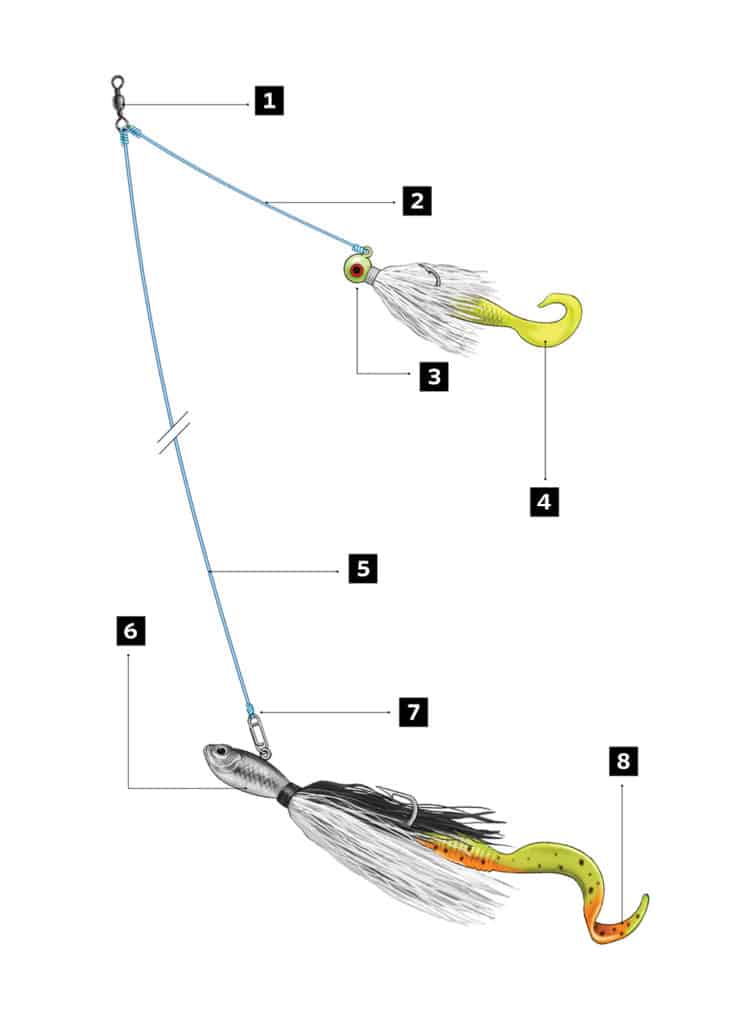
Tandem-Bucktail Rig
[2] 6 inches of fluoro leader
[3] 3⁄8-ounce bucktail jig
[4] 5-inch Gulp! Swimmin’ Mullet
[5] 18 inches of 25-pound fluoro leader
[6] 4-ounce bucktail jig
[7] 50-pound TA clip
[8] 6-inch Gulp! Grub Steve Sanford
Capt. Austin Perilli on Bucktail out of Brooklyn, New York, targets deepwater fluke in Sandy Hook Channel, Raritan Reach and Ambrose Channel off the New Jersey-New York Bight, where depths reach 60 to 100 feet. “Our deepwater fluking usually starts in July and lasts through September, when the fish hunker down to beat the summer heat.” You can’t always count on finding fluke where they have been historically, so the key to catching large ones in deep water is understanding what locations appeal most to the fish. In 2017, fluke fishing off New Jersey and New York was tough. Nearshore action was a far cry from what it should have been, but Perilli believes he figured out where the fish were then: deep water, and not just in the channels along the coast. “A commercial fisherman I know stated that, last spring, the big fluke stayed in 80 to 100 feet of water around wrecks and rock piles in the Mud Hole, some 10 to 20 miles offshore. Schools of sand eels and squid provided ample forage, keeping the fish out there all summer.”
Capt. Matt Sellito of Helen-H out of Hyannis, Massachusetts, plies the waters of Nantucket Shoals, a 25- to 35-mile ride, fishing depths down to 130 feet to haul in doormats. “Our grounds are mostly shifting sandy-bottom shoals, but we do have mussel beds that act as structure piles where fluke hang around. Generally, we start out in deep water in May, when the fish are following the squid run as they move in.” Off Nantucket, fluke root down in the deep cuts and holes to feed on squid and sand eels through the summer months.
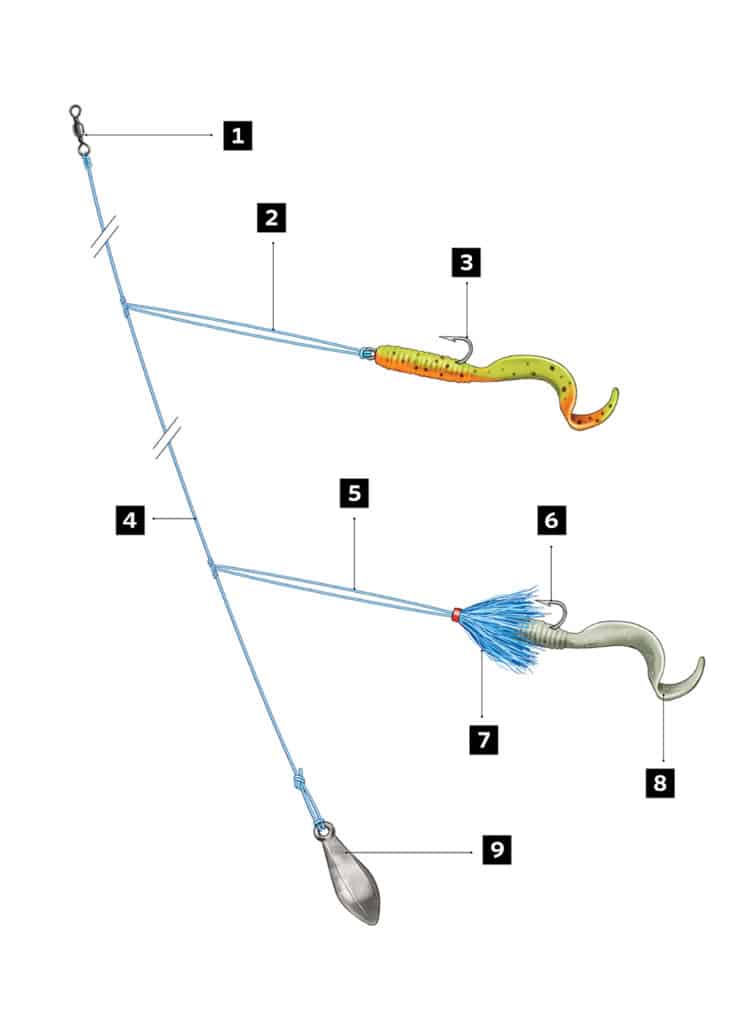
High-Low Rig
[2] 6-inch dropper loop
[3] 9/0 Baitholder hook
[4] 36 inches of 100-pound fluoro leader
[5] 6-inch dropper loop, 18 inches below upper dropper
[6] 9/0 Baitholder hook
[7] Slide-on bucktail teaser
[8] 6-inch Gulp! Grub
[9] Bank sinker 6 inches below dropper Steve Sanford
How to Fish Bucktails for Fluke
Perilli’s deepwater doormat-fluke rig starts and ends with a bucktail. He ties a 75-pound Spro barrel swivel to one end of an 18-inch section of 25-pound Seaguar fluorocarbon, then ties a 50-pound TA clip on the other end, fixed with a pink, chartreuse or white 1- to 4-ounce bucktail tipped with either a 6-inch Berkley Gulp! Grub or a strip of sea robin or bluefish. Then he attaches a 3⁄8-ounce white round-head bucktail to a 6-inch piece of the same fluorocarbon leader, ties it off the bottom eye of the swivel, and tips it with a 5-inch Berkley Gulp! Swimmin’ Mullet to complete the killer tandem-bucktail rig.

Perilli doesn’t just gravitate toward deep water, he also looks for clues that’ll point him to spots that hold fish. “Find hard structure and obstructions such as wrecks, rock piles, and the ballast of buoy markers in the deep channels,” says Perilli. “Anywhere you find a little piece of structure in deep water is a good place to start. But pick a structure pile and fish right on top to avoid extended drifts over barren bottom.” Fluke hang close to structure, and they use it to hide and ambush prey, as well as feed off its ecosystem, which includes such forage as crabs, mussels and various baitfish. “Every fluke over 10 pounds I’ve caught had structure-oriented creatures in its gullet — crabs, mantis shrimp, bergall, porgies, sea bass — proving the big fish are feeding in and around deepwater structure,” adds the fishing guide.
“Bucktailing for fluke is not about getting out at sunup or sundown but about figuring out when slack tide is,” says Perilli. “You want to hit it when the water is at a dead stop or moving at its slowest, so the peak action usually happens from two hours before slack tide until two hours after. The key is to bang out mini drifts, or to power-drift and fan-cast the bucktails to really pick apart a spot. Bucktails should always maintain contact with the seafloor, so impart a slight bouncing motion and keep tapping the bottom. If the current starts to push hard and you start to drag the bucktail, it’s time to power-drift or find another spot where the tide has yet to catch up.”
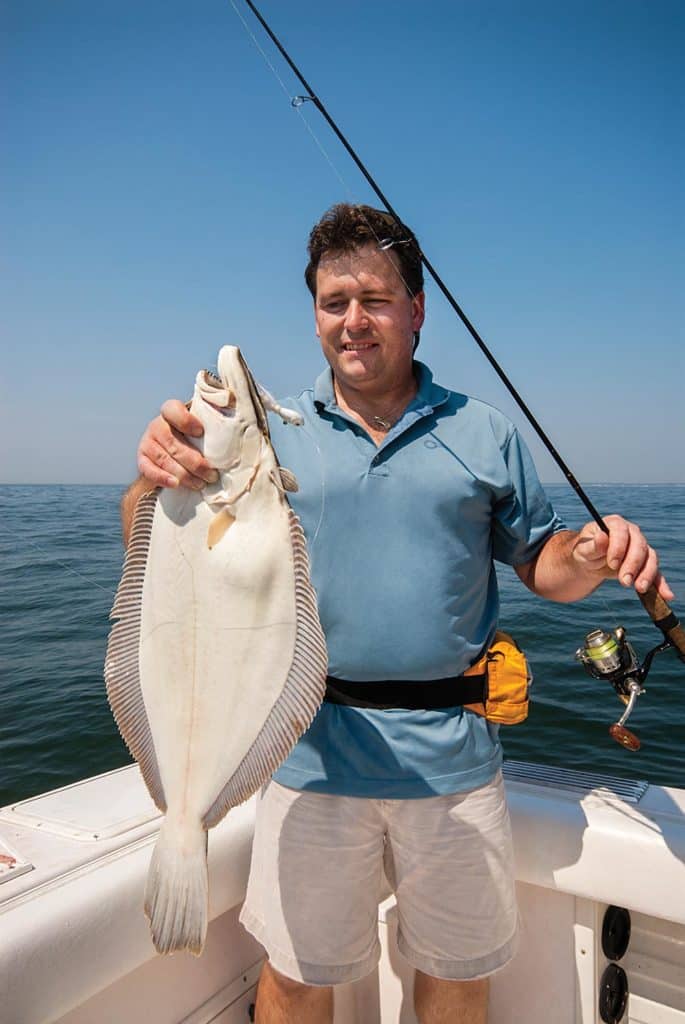
Use Strip Baits to Catch Fluke
“The majority of 10-plus-pounders we get are caught dragging big bait strips,” states Capt. Sellito. “Successful anglers are dragging long strips of belly bait, such as little tunny or Peruvian smelt, cut 10 to 14 inches long.” Sellito states the standard rig for trophy fluke aboard Helen-H is a No. 1 three-way swivel with a sinker snap, a 10- to 24-ounce bank sinker, and a leader coming off the second swivel eye with a tandem of 6/0 to 7/0 Gamakatsu Octopus hooks on the end. Fast drifts require a 48-inch piece of 30-pound fluorocarbon leader; for slow drifts, a 24-inch section will do.
“To hook deepwater fluke on the drift with strip baits, it’s essential to let ’em eat,” explains Sellito. “When you feel the weight of a flounder on the line, it has mouthed the bait and is sitting on it. So drop it back in free-spool, give it a standing five count, then set the hook. Lift the rod slowly to feel for the weight of the fish hanging on the bait. If you don’t feel any weight, send the bait back down and feed it to him.” One of Sellito’s top-secret tactics is to catch live squid with a squid jig off the bottom at Nantucket Shoals, then live-line the squid on the described two-hook tandem rig.
To battle currents down in the deep, veteran big-fluke hunters aboard Helen-H also use the chicken rig, better known as a variant of the high-low rig. Start with a 100-pound barrel swivel tied to a 36-inch piece of 30-pound fluorocarbon, make a dropper loop 12 inches down and attach a 9/0 Baitholder hook tipped with a 6-inch Berkley Gulp! Grub. About 18 inches down from the first dropper loop, make a second one and add another 9/0 hook to it with a small slide-on bucktail teaser and a Gulp! Grub. Finish the rig with a double overhand knot 6 inches down, forming a loop to connect a bank sinker.
Action with trophy flatties off Nantucket has been legendary the past five years and shows no sign of slowing. For a good gauge on the quality of deepwater fluke there, Sellito says: “When we see a 4- to 5-pound fluke come up, we don’t even reach for the net. We’re here for the 6- to 14-pounders; no sense in wasting time with the little ones.”
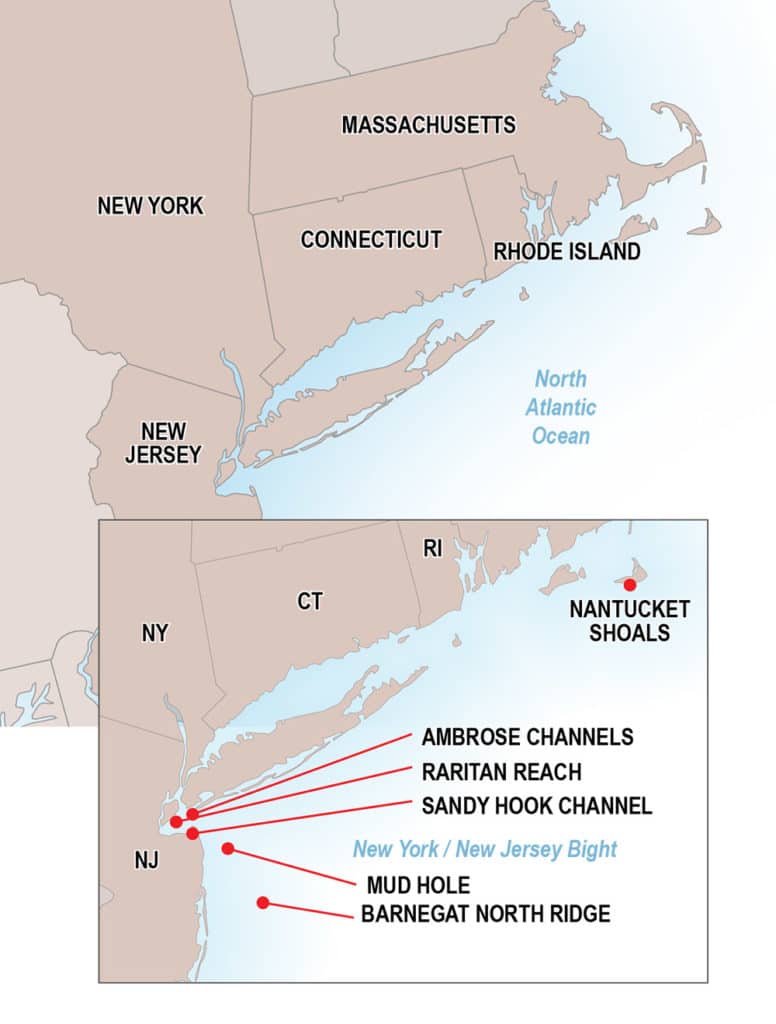
Catch Fluke in the Summer
- What: Summer flounder, aka fluke
- Where: Massachusetts to New Jersey
- When: Summer through fall
- Who: The following charter captains know where to find trophy flatties.
Brooklyn, New York
- Capt. Austin Perilli
- Bucktail Charters
- 732-773-2756
Hyannis, Massachusetts
- Capt. Matt Sellito
- Helen-H
- helen-h.com
- 508-790-0660
Fishing Tackle for Fluke
- Rods: Tsunami 6-foot-4-inch Slim Wave SWSPS641-MH for spinning, Tsunami 7-foot Airwave TSAWIC-701H for baitcasting, Shimano 7-foot Tallus Bluewater TLC70XHBBL conventional
- Reels: Shimano Stradic 3000 to 5000 spinning, Calcutta 400 baitcasting, Torium 20 conventional
- Line: 14- to 50-pound braid, 25- to 30-pound fluorocarbon leader
- Lures: 3⁄8- to 4-ounce Andrus Spro bucktails, Berkley Gulp! 5-inch Swimmin’ Mullet and 6-inch Grub
- Terminal Tackle: Spro 75-pound barrel swivel and No. 1 three-way swivel, 50-pound TA clip, 6- to 24-ounce bank sinker, 6/0 to 7/0 Gamakatsu Octopus and 7/0 to 9/0 Baitholder hooks
- Baits: bluefish, mackerel or sea robin belly strips

